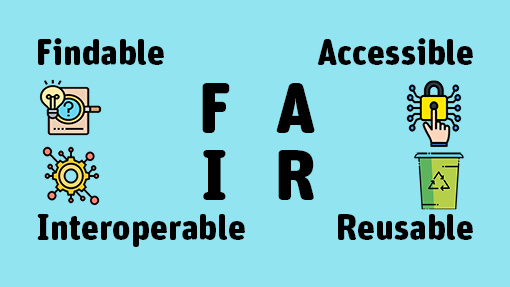What is FAIR data and why should you care?

Data is at the foundation of research and progress in any field relies on making data available and reusable to others. Data that is shared enhances integrity, promotes transparency and drives research forward faster.
The FAIR Guiding Principles, published in 2016, were developed by a group of researchers, librarians, publishers and research funders (known as FORCE11) to support the discovery and reuse of data. To be FAIR data need to be findable, accessible, interoperable and reusable. Recognising that data needs to be made accessible not only to researchers but to computers as well, the principles focus on “enhancing the ability of machines to automatically find and use the data, in addition to supporting its reuse by individuals”. FAIR principles apply to all parts of the research process (including algorithms, tools, and workflows) since all are essential to the transparency, reproducibility, and reusability of research.
The principles sound quite straightforward, but what do you need to do to make your data FAIR?
Findable
The principle of findability means that your data and metadata (data about the data) should be easy for both humans and computers to find.
The best way to make sure your data are findable is to use a data repository. Use a reputable repository, preferably one that complies with international standards (e.g. CORE trust seal) and is FAIR-aligned. Most repositories assign persistent identifiers to the data they hold (e.g. a DOI) so that there will be a permanent record for your data which will make it easy for potential users to locate and cite.
You’ll also need to think about the metadata that describes your data as this is key to others being able to find it. Most repositories use metadata standards so it’s likely the categories will be decided for you. Using discipline-specific standards can help to describe your data in terms relevant to your discipline. The Metadata Standards Catalog is a really useful resource for finding these.
Please note you should only deposit your data in a repository once your research project has ended. Whilst you’re in the active phase of your project you’ll need to consider appropriate storage solutions so that those who need to access the data can do this securely.
Accessible
You’ll also need to make sure that once users find your data, they can access them. Using a repository enables others to access your data. If access to your data needs to be restricted then choose a repository that can ensure this happens by setting appropriate controls.
If the data are no longer available, the metadata should still be accessible. Metadata can help others to find out what happened to the data and to locate individuals and publications linked to the data.
Interoperable
When data is interoperable it means they can be integrated with other data and work with applications or workflows for analysis, storage, and processing.
Where possible use standard and/or open file formats for your data. The UK Data Service recommends open formats as they can be interpreted by most software packages and are most likely to persist in the future and they provide a useful list of recommended formats for long term preservation.
Interoperability is also facilitated by using controlled vocabularies common to your field so you should use these alongside standardised structural metadata for your data. You can read more about using shared languages for knowledge representation on the GO FAIR website.
Reusable
To ensure your data are reusable you’ll need to create documentation for your data so that users can fully understand it. Documentation can include contextual information such as methods, codes and sampling tools; it can be embedded within the data files or accompany the data as a README file. You can read more about how to document your data here.
It’s important to think about licencing as this helps to clarify what others can do with your data. Creative Commons licences are among the most common licences applied to data.
Include links to any articles or other research outputs related to your data- this will enable users to contextualise and understand your data. You should also include a citation for the data itself so that others can cite your data accurately and give you appropriate recognition.
FAIR and Open Data are not the same!
So those are some of the things you can do to make your data FAIR. It’s important to recognise that FAIR data and open data are two completely different things. Not all data can be made open due to issues of sensitivity and confidentiality amongst others, but this data can still be FAIR. Open data should always be FAIR but not all FAIR data must be open.
In summary, the FAIR principles are a really helpful way of supporting good data management. More importantly, they enable research to reach ever wider audiences, facilitating collaboration and innovation through discovery and access.
If you’d like to know more about making your research data FAIR, please contact the Scholarly Communications team at WIRE@wlv.ac.uk
Sarah Dar, Scholarly Communications Officer
Useful guidance
https://www.go-fair.org/fair-principles/
https://www.openaire.eu/how-to-make-your-data-fair
https://www.howtofair.dk/how-to-fair/ Online course which explores various aspects of FAIR.
https://faircookbook.elixir-europe.org/content/home.html Useful guidance for those working in the Life Sciences
For more information please contact the Corporate Communications Team.


/prod01/wlvacuk/media/departments/digital-content-and-communications/images-2024/240328-Varsity-Line-Up-Resized.jpg)
/prod01/wlvacuk/media/departments/digital-content-and-communications/images-18-19/220325-Engineers_teach_thumbail.jpg)
/prod01/wlvacuk/media/departments/digital-content-and-communications/images-2024/240423-Additive-Research-Centre-Launched.jpg)
/prod01/wlvacuk/media/departments/digital-content-and-communications/images-2024/240229-The-Link-Resized.jpg)
/prod01/wlvacuk/media/departments/digital-content-and-communications/images-2024/240416-Abi-Dare-Resized.jpg)